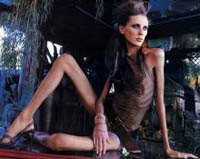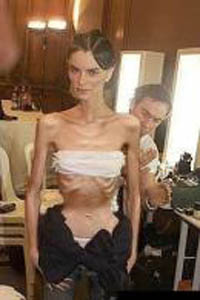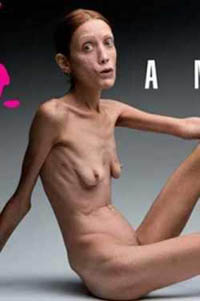Body Image and the Media
Most of us have a strong investment in our personal appearance. Our self-esteem is greatly influenced by how we feel when we look in the mirror. How we interpret what we see is a reflection of how we compare ourselves to the dominant standard of beauty in our society. The ideal standards of beauty are greatly influenced by the images depicted in the media. In the last four decades there has been an explosion of particular images in fashion magazines, television, films and more recently the internet that has contributed to a laser like focus on the body. These images have produced a new ideal of beauty that is one of perfect body parts often at the expense of the heart, mind and soul.
The message of the mainstream media is that happiness and success is defined by images of fashion models who are starvation-thin, tall, young, gorgeous and flawless. The messages imply further that Cinderella may find her handsome prince but she must be a size 2 to find him. In short, the mainstream media tells us an unrealistic story about the real meaning of happiness and success.
Even Halle Berry, who is considered to be beautiful by most standards, said that “Beauty, or being thought of as beautiful, has not spared me any heartache or trouble.” She adds, “Beauty is always transitory”. The ideal images displayed for men in magazines, film and other media venues are that of tall, handsome, muscular and very sexual. Men who fall short of this ideal image portrayed in music videos, and men’s magazines strive to make themselves “more perfect” through an obsession with weightlifting and an alarming increase in steroid use. Women tend to diet and exercise to extremes. Anyone whose look is less than the ideal often become targets of both rejection and humiliation in sitcoms, film and commentary on the internet. Therefore, people of both sexes become even further driven in their effort to achieve these ideals that will ultimately help achieve their desires and enable them to obtain their ideal sexual partner. The mixed messages received by audiences that “thin is in” coupled with diet, cosmetic and fashion industries that promote this ideal with quick fixes for those who aren’t young, svelte and successful are a lethal combination.
A study conducted by the magazine “Psychology Today” in the 1980’s found that 3 out of 10 American women were unhappy with their physical appearance. By the mid 1990’s that figure increased to 1 in 2. In a more recent and disturbing survey over 30% said they had fasted or starved themselves in order to achieve a more tantalizing body that was closer to an ideal image. Their ideal image conforms to the latest glamorous celebrity on magazine covers, the latest film, music videos or television.
According to a recent article in Newsweek, “Classic eating disorders such as anorexia or bulimia are being diagnosed at younger ages (some as young as eight or nine) and with greater frequency than any time in our history.” It is estimated that over 10 million women and 1 million men have been diagnosed with eating disorders in the U.S. The very secretive nature of binging and starvation is such that these numbers are probably underrepresented. Just as startling, are the trends at the opposite end of the spectrum which show that 65% of adults and 30% of children are overweight or obese. Interestingly, there appears to be a correlation between the number of hours people watch television and chat online related to this phenomenon. Ten or twenty years ago families played outdoors and gathered with friends. The current trend is 4-6 hours of television viewing per day and even more time spent on the internet.
Our body image is closely related to what we see in the media. Body image refers to the way we see ourselves and how we think others see us. A healthy body image involves accepting one’s own body and feeling comfortable in one’s own skin. When a negative body image is magnified and taken to the extreme, a person develops a distorted perception of themselves as being heavier or thinner than they really are. Many therapists believe that it is this contradiction between how people feel they look versus how they believe they should look that is one of the contributing factors in the development of an eating disorder. People who have what is known as Body Dysmorphic Disorder (BDD) have such an exaggerated view of their appearance that they become obsessed about perceived flaws to the point where they describe themselves as “ugly or hideous”. They may apply large quantities of make-up or clothing to cover the perceived defect. Even more extreme is repetitive and unnecessary plastic surgery procedures to look like somebody else that they might admire. So the important question to ask is “How did we get to this point as a culture and what can we do to modify this downward spiral?”
The standards of beauty and the ideal body shape have changed throughout history. In the Middle Ages, an anorexic appearance was seen as a sign of saintliness or godliness. However, during the Renaissance period, the standard of beauty was a woman who was Rubinesque and curvaceous. This perception was depicted in what was considered to be erotic forms of art by famous painters such as Rubens, Goya and Raphael.
At the beginning of the baby boom era people still preferred a voluptuous body type such as Marilyn Monroe who represented the ideal in the media. The 1960’s ushered in the idealization of the thin supermodel that began with a waif-like British model named “Twiggy”. The standards today are even more closely identified with the “thin and famous” like Kate Moss, Jennifer Aniston, etc. that bombard us daily.
Amazingly most of us survive the media onslaught of unrealistic images of the perfect body. We can help empower and encourage people to value themselves and their unique qualities rather than to base self-esteem on false notions. It is critical that we allow people to discover the right look and feel that suits them. This will require a shift in attitude that enables people to love and accept their bodies and celebrate our differences. Then perhaps, soon we won’t strive to have that “body to die for”.






